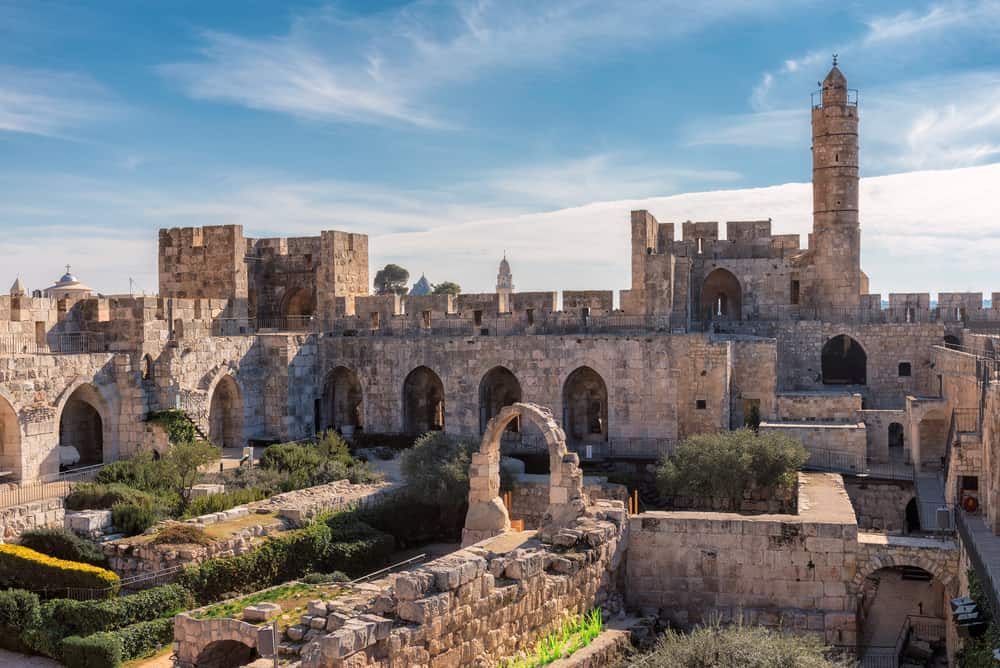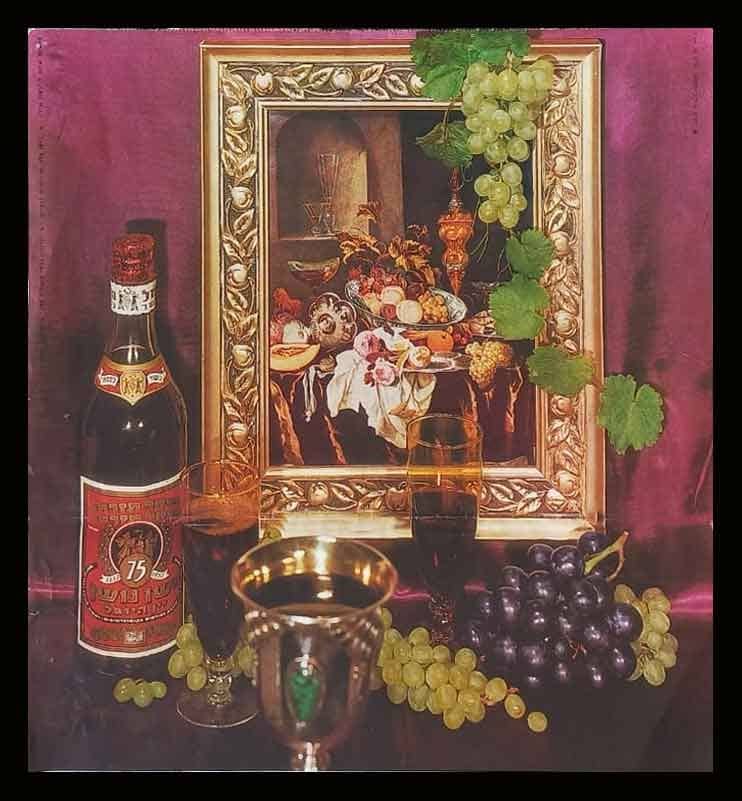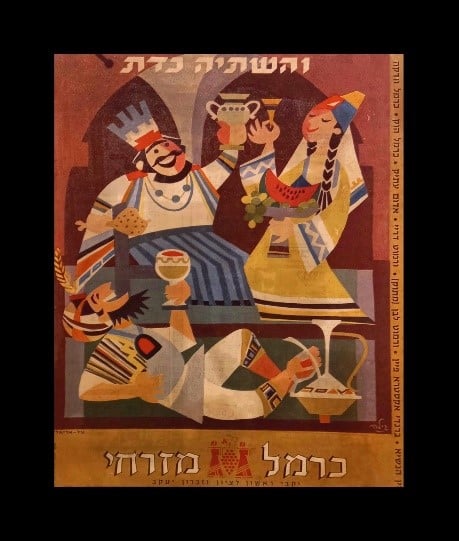
3000+ Years of Winemaking: The Blessed Fruit!
The fruit of the vine is one of the seven blessed fruit varieties found in the land of Israel, according to the book of Deuteronomy.
According to the Book of Numbers, Moses sent spies to scope out the Promised Land. They returned with clusters of grapes so large that they had to be suspended from a pole and carried by two men. Today, both Carmel Winery and the Government of Israel use this image as their logo. The grapes were selected to symbolize that the land flowed with milk and honey; the vine links one of the blessings of the Promised Land –the promise to the children of Israel.
Then came King David (3000 BCE, approximately) who is reported to have had an extensive wine cellar with a staffer assigned to selecting wines for his meals (the world’s first sommelier?). Wine production was halted in 600 BCE by an Islamic invasion and the vineyards of Israel were destroyed. Monks living in monasteries and Jewish communities practicing religious rites were permitted to include wine for sacramental purposes – but – nothing else.
Wine from Israel was exported to Rome during the Roman period and the industry was temporarily revitalized during the control of the Crusaders (1100-1300). Although wine restarted briefly, the invasion and control of the Ottoman Empire (1517-1917) put a full stop to wine production in Israel for 400 years. It was not until the 19th century (1848) that a winery was opened in Israel by Yitzhak Shor; unfortunately, the wine was exclusively used for religious purposes. Finally, French-born Baron Edmond James de Rothschild recognized the opportunity for the wine industry in Israel and the rest is history.
The Rothschilds know about wine – this is the family behind the Bordeaux, France, Château Lafite Rothschild. Their billion-dollar investments (starting in 1877) included vineyards as well as educational opportunities so that residents could learn how to make quality wine in the country. The impetus and support of the Rothschild family sparked the Israeli wine industry and Carmel Wine Company was started in 1895, selling wines of Rishon LeZion and Zichron Ya’akov, establishing the modern-day wines of Israel.
During the early 1900s, Israel was focused on independence (in May 1948, Israel officially declared an independent state) and winemaking was halted. Finally, in the 1970s, it was resumed and modern winemaking techniques were introduced making wine for enjoyment and not just an alcoholic beverage for religious purposes. In the 1980s California experts were brought to Israel to introduce up-to-date techniques that impacted positively on the winery and in the vineyard. In the 2000s Israeli wine became terroir-driven making wine from single vineyards as well as identifying and separating characteristics from individual plots within a vineyard.
Israel harvests approximately 60,000 tons of wine grapes and produces over 40 million bottles of wine yearly.
The industry supports 70+ commercial wineries and the ten largest wineries control over 90 percent of the production. Exports are valued at $70+ million. Over 55 percent of the exports head to the USA, approximately 35 percent is directed to Europe and the remainder is shipped to the Far East.
Attributes of Israel
Israel is an Eastern Mediterranean country bordered by the Mediterranean Sea to the west and surrounded by Lebanon, Syria, Jordan, and Egypt to the north, west, and south. The land mass is approximately 7,992 sq. miles and stretches 263 miles from north to south, supporting a population of 8.5 million people. The mountain ranges include Mount Hermon/Golan Heights, Mount Meron in Upper Galilee, and the Dead Sea, the lowest point on earth. The combination of sun, hills, and mountainous areas features soils of limestone, terra rossa (reddish, clay to silty soil with neutral pH conditions with good drainage characteristics), and volcanic tuff creating a winemaking paradise.
The fertile part of the country has a Mediterranean climate consisting of long hot dry summers and short cool rainy winters with snow occasionally appearing on the higher elevations, especially the Golan Heights, Upper Galilee and Judean Hills. The Negev Desert covers more than half the country and there are semi-arid areas. The major impact of the climate is the Mediterranean Sea with winds, rain, and humidity coming from the west. Rain in the winter is very limited and because of rain shortages during the growing season, drip feed irrigation is essential. This technique was pioneered by the Israelis in the early 1960s and is now used throughout the world.
In the Vineyard
Most vineyards planted in the last 25 years conform to a standard: 1.5 meters between vines and 3 meters between rows. The usual vineyard density is 2220 vines per hectare. There is a preference for mechanical harvesting allowing a night harvest to be completed in a few hours, at the optimum time, and brought to the winery in the cool temperature of early morning.
Canopy management is very important in a hot country and it is necessary to reduce the vigor of the vines and protect the grapes from over-exposure. Most vineyards are cordon spur pruned in a VSP vertical shoot position. Some older vineyards are planted in a goblet, bush vine format, and in the Judean Hills, some vineyards are planted in stone-lined terraces. The older vineyards may not need irrigation as the roots of the vines have dug deep into the stony soil over the years and receive the water required. These vines are hand harvested.
Wine Renaissance
Currently, Carmel is the largest winery in Israel, controls almost 50 percent of the local market, and is the third largest Israeli industrial company by sales volume (Dunn & Bradstreet, Israel), with sales of $59.2 million and an annual growth rate of 5 percent +/-. Carmel produces almost 20 million bottles a year; the closest competitor is Barkan-Segal winery.
Carmel had a humble beginning. The organization started in 1895 and exported wines to Poland, Austria, Great Britain, and the US. In 1902, Carmel Mizrahi was started in Palestine to market and distribute wines to the cities of the Ottoman Empire.
By the end of the 19th century, Carmel wines were good enough to be presented at the International Exhibition of Berlin at a pavilion devoted to the industries of the Jewish colony in Palestine. Thousands visited the exhibition and had a sip of Carmel’s Rishon Le Zion wine. One year later, another exhibition was held in Hamburg where the settlers’ wines were well received and Rishon LeZion won a gold medal at the Paris World’s Fair (1900). At the beginning of the 20th century, Carmel expanded its operation with branches in Damascus, Cairo, Beirut, Berlin, London, Warsaw, and Alexandra.
Sales increased during the First World War. When the war ended, sales declined as the industry lost a major market in Russia (military conflicts), in the US it was the beginning of Prohibition, and in Egypt and the Middle East, it was the start of Arab nationalism. Once again, Israeli vineyards were uprooted and replanted with citrus trees.
The Second World War jump-started the wine industry and waves of immigrants changed their drinking habits. In 1957, Baron Edmond de Rothschild deeded two wineries to the Cooperative of Winegrowers, the Société Cooperative Vigneronne des Grandes Caves, better known under the trade name Carmel Mizrahi in Israel and Carmel worldwide. Sweet wines with a religious focus were a Carmel anchor product; however, with the emergence of the new world in winemaking, Israeli winemakers started to look for new varietals. By 1971 Cabernet Sauvignon and Sauvignon Blanc were good enough to be presented in the US market.
Unfortunately, the 1980s saw another slump in the wine industry but the winemakers were able to recover by the middle of the decade as demand for quality wines developed and the improved winemaking techniques were incorporated by the winegrowers enabling the wines of Israel to be competitive on the world stage.
Carmel Ownership
Carmel is owned by the Council of the Vine-growers Union (75 percent) and the Jewish Agency for Israel (25 percent). The parent company is Société Cooperative Vigneronne des Grandes Caves Richon Le Zion and Zikhron Ya’akov Ltd.
Carmel’s first location was Rishon LeZion Winery, built in 1890 by Baron de Rothschild, making it the oldest industrial building in Israel still in use. It is the first enterprise to install electricity and telephone and David Ben-Gurion (Israel’s first prime minister) was an employee.
In terms of production, it is the largest winery in Israel (produces wine, spirits, and grape juice) and the largest producer of kosher wine in the world. The enterprise has won more medals than any other Israeli wine producer.
Carmel Winery owns many vineyards throughout Israel and they include some of the finest individual vineyard sites in the country. An average Carmel harvest totals approximately 25,000 tons of grapes, just about 50 percent of Israel’s total harvest. The wine-growing areas are considered among the best because of their higher altitudes and cooler climates.
Carmel. Taste of Israel
Carmel. 2020 Appellation. Cabernet Sauvignon, Upper Galilee. Dry Red Wine. Kosher for Passover, Mevushal. Extended fermentation with skins; aged in French oak barrels for 12-months. The wine is not fined and coarsely filtered prior to bottling; natural sediment may appear during bottle maturation.
The term kosher means “pure.” The target markets include orthodox Jews who observe Jewish Dietary laws. Kosher wines can be world class, receive excellent scores and win international awards. The wines are produced using the same procedures as non-kosher wines. In terms of quality, the kosher designation is irrelevant.
The Galilee is an administrative and wine region in northern Israel. “Water into wine” is a theme of the region based on the historical reference of a wedding at Cana, where Jesus turns water into wine. The soil types include free-draining gravels, limestone based and mineral-rich volcanic basalt. The area is characterized by rocky elevations of over 450 meters (1500 feet). The cool elevations and relatively high rainfall in this area allows the grapes to retain their acidity and produce a wine that is fresh and vibrant.
Notes
Deep purple to the eye and hints of fresh blueberries delights the nose, along with cassis. The wine tastefully delivers ripe, rich fruit and intense flavor (think Australian Shiraz, Chateauneuf-du-Pape) to the palate thanks to suggestions of pepper, spice, raspberry, fresh cherry, plums and leather. Delicious to sip during great conversations or pair with steaks, and meat-sauce pasta.


© Dr. Elinor Garely. This copyright article, including photos, may not be reproduced without written permission from the author.
